Dogs
Are Strawberries Good for Dogs? Essential Guide
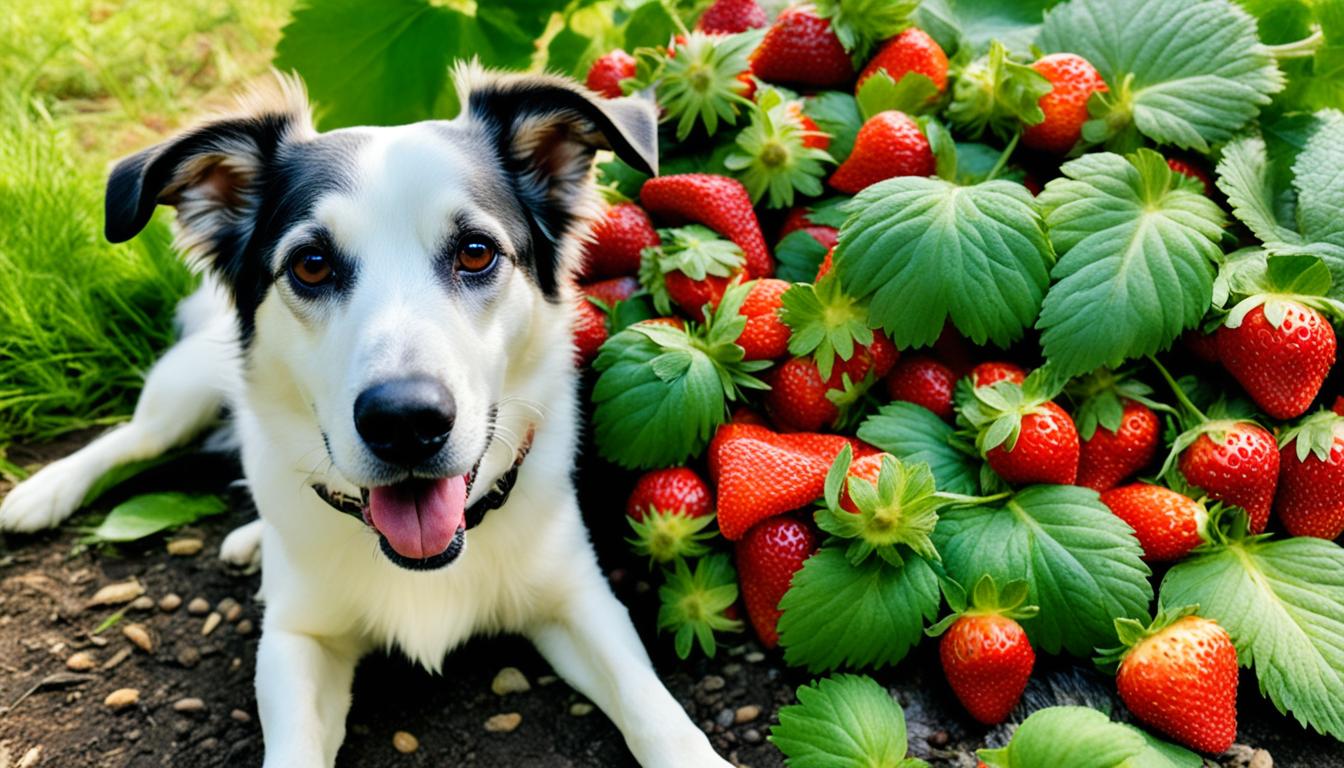
Did you know that strawberries offer more than just a sweet treat for humans? They are also a surprisingly healthy option for dogs! Strawberries are packed with essential nutrients that can benefit your furry friend’s overall health and well-being. But before you start sharing your strawberry snacks with your canine companion, there are a few important things to know.
Key Takeaways:
- Strawberries are safe for dogs to consume in moderation.
- They are rich in antioxidants, vitamins, and minerals.
- Strawberries can promote a healthy immune system and aid in digestion.
- It’s important to follow safe consumption guidelines and be aware of potential risks.
- Consult with a veterinarian for personalized advice on incorporating strawberries into your dog’s diet.
Benefits of Strawberries for Dogs
When it comes to the health of our furry friends, incorporating nutritious foods into their diet is crucial. Strawberries are not only delicious for humans but can also bring a myriad of benefits to dogs. These vibrant red berries are packed with essential nutrients that promote overall wellbeing and support various bodily functions.
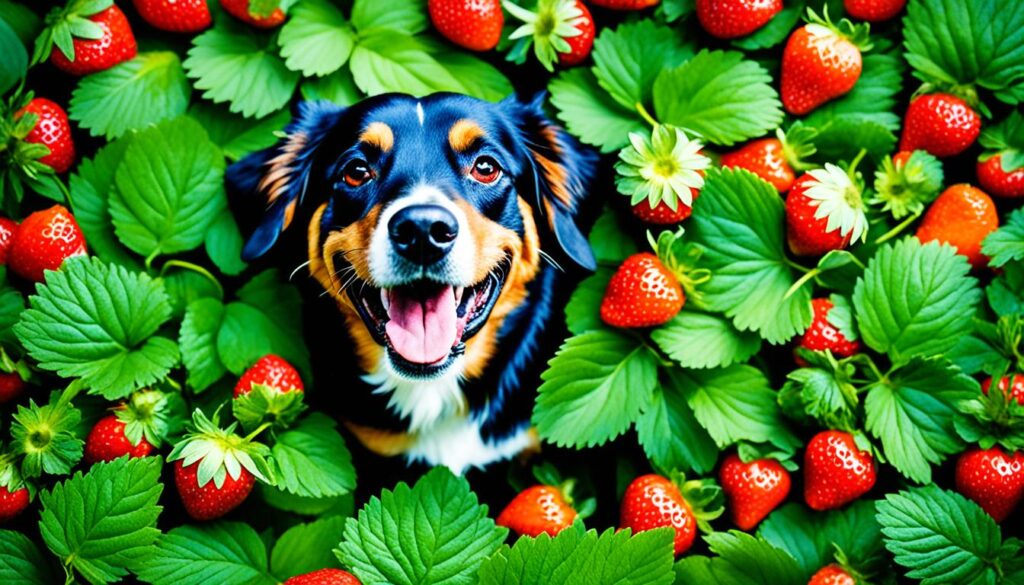
Here are some key health benefits that strawberries offer to dogs:
Promotes a Healthy Digestive System
Strawberries contain fiber, which plays a vital role in maintaining a healthy digestive system in dogs. Fiber aids in proper digestion and prevents common digestive issues such as constipation and diarrhea.
Supports the Immune System
Vitamin C is a powerful antioxidant found in strawberries that helps boost the immune system of dogs. This essential vitamin plays a key role in fighting off harmful pathogens and protecting against illnesses.
Reduces Inflammation
Strawberries are rich in antioxidants that help reduce inflammation in dogs. Inflammation can lead to various health issues and discomfort, so incorporating strawberries into their diet can have a positive impact on overall wellbeing.
Aids in Fluid Balance and Muscle Function
Potassium is a crucial mineral found in strawberries that aids in fluid balance and muscle function in dogs. It helps maintain proper hydration levels and supports healthy muscle contractions.
Contributes to Bone Development and Blood Clotting
Strawberries provide important nutrients for bone development and blood clotting in dogs. They are rich in calcium, iron, magnesium, phosphorus, and vitamin K, all of which play a role in maintaining healthy bones and ensuring proper blood clotting.
By incorporating strawberries into your dog’s diet, you can provide them with these essential nutrients and enjoy the numerous health benefits they offer. However, like any food, moderation is key. It’s always important to consult with a veterinarian before making any significant changes to your dog’s diet.
Potential Risks of Feeding Strawberries to Dogs
While strawberries are generally safe for dogs, it’s important to be aware of the potential risks associated with feeding them this delicious fruit. Here are some of the key risks and dangers to consider:
Choking Hazard:
Strawberries, especially whole ones, can pose a choking hazard for smaller dogs. To minimize this risk, it is essential to cut strawberries into small, bite-sized pieces before offering them to your furry friend.
Stomach Upset:
Natural sugars present in strawberries can cause gastrointestinal discomfort if consumed in excessive amounts. Dogs with sensitive stomachs or those prone to digestive issues may experience diarrhea, vomiting, or an upset stomach. It is best to feed strawberries in moderation, especially if your dog has any preexisting digestive conditions.
Pesticide Residues:
Unwashed strawberries may contain pesticide residues, which can be harmful to dogs if ingested. To minimize this risk, it’s recommended to thoroughly wash strawberries before feeding them to your pet. Opting for organic strawberries can also reduce the potential exposure to pesticides.
By being mindful of these potential risks and taking necessary precautions, you can safely incorporate strawberries into your dog’s diet and enjoy the many benefits they offer.
| Risks | Precautions |
|---|---|
| Choking Hazard | Cut strawberries into small pieces |
| Stomach Upset | Feed strawberries in moderation and monitor your dog’s response |
| Pesticide Residues | Thoroughly wash strawberries before feeding and consider organic options |

Note: Always consult with your veterinarian if you have any concerns or questions about feeding strawberries or any other food to your dog. Their professional guidance will help ensure the safety and well-being of your furry companion.
Safe Consumption Guidelines for Strawberries
When it comes to feeding strawberries to your furry friend, following safe consumption guidelines is essential. Here are some tips to ensure a positive and enjoyable experience:
- Offer strawberries in moderation: While strawberries provide health benefits, they should be given as a treat in moderation. Consider your dog’s size and dietary needs when determining the appropriate portion size.
- Rinse thoroughly: Before serving strawberries to your dog, make sure to rinse them thoroughly. This helps remove any dirt or potential chemicals that may be present on the surface.
- Cut into small pieces: To prevent choking hazards, it’s important to cut strawberries into small, bite-sized pieces. This ensures that your dog can safely enjoy this delicious fruit.
- Remove leaves and stem: While the leaves and stem of strawberries are not toxic to dogs, they can be tough to digest. It’s recommended to remove them before feeding strawberries to your furry companion.
- Consider frozen strawberries: Frozen strawberries can be a refreshing treat, especially during warmer months. They provide a cooling sensation and can serve as a great way to keep your dog hydrated.
- Mashed strawberries: Another way to incorporate strawberries into your dog’s diet is by mashing them and mixing them with their regular food. This can add a burst of flavor and nutrition to their meal.
By following these safe consumption guidelines, you can ensure that your dog enjoys strawberries in a safe and healthy manner.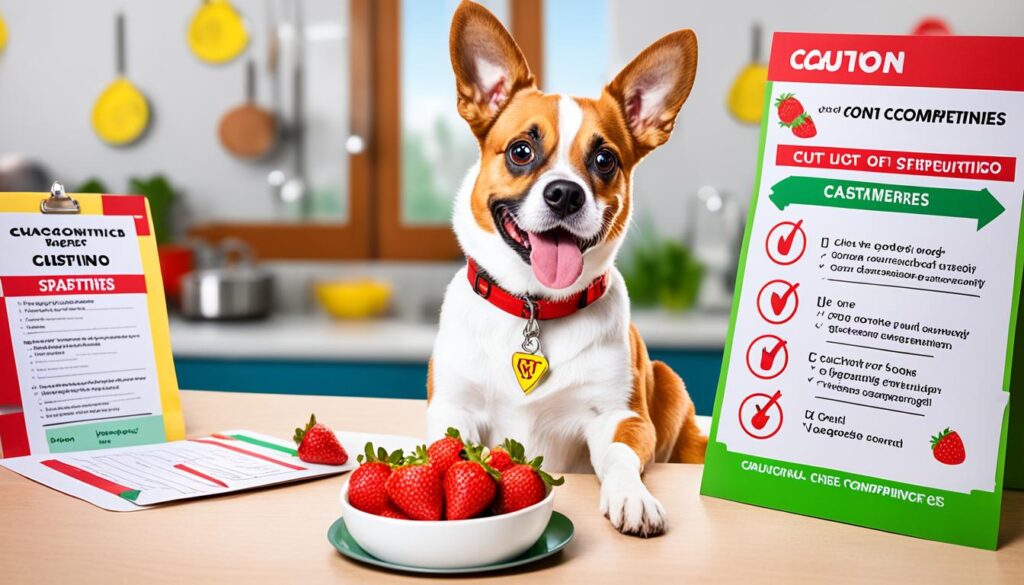
“Offer strawberries in moderation, rinse thoroughly, cut into small pieces, remove leaves and stem, consider frozen strawberries, and try mashed strawberries as a topping.”
Can Dogs Eat Various Strawberry Items
When it comes to feeding strawberries to your furry friend, not all strawberry items are created equal. Let’s take a look at some common strawberry items and whether they are safe for dogs to consume:
Fresh Strawberries
Fresh strawberries are safe for dogs to eat in moderation. They are packed with nutrients like antioxidants, vitamins, and minerals that can benefit your dog’s health. However, it’s important to remember that strawberries should only make up a small portion of your dog’s overall diet.
Canned Strawberries
Canned strawberries, on the other hand, are not recommended for dogs. They often contain added sugars and preservatives, which can be harmful to your dog’s health. It’s best to stick to fresh strawberries to ensure your furry friend gets the most nutritional benefits without any unnecessary additives.
Strawberry Leaves
Strawberry leaves themselves are not toxic to dogs, but they may pose a choking hazard or cause digestive upset if ingested in large quantities. It’s advisable to remove the leaves before offering strawberries to your dog as a precaution.
Strawberry Yogurt and Ice Cream
While dogs can consume plain yogurt in moderation, strawberry yogurt and ice cream are not recommended. These products often contain high amounts of sugar and potentially harmful additives. Excessive sugar intake can lead to weight gain, dental issues, and other health problems in dogs. It’s best to avoid giving your dog strawberry yogurt or ice cream altogether.
In summary, fresh strawberries are a safe and nutritious treat for dogs when fed in moderation. However, it’s important to avoid canned strawberries, remove strawberry leaves, and steer clear of strawberry yogurt and ice cream due to added sugars and potential harmful additives. Stick to fresh or frozen strawberries without any added sugars or chemicals to ensure your dog can enjoy this tasty fruit while reaping the health benefits.

| Strawberry Item | Can Dogs Eat It? |
|---|---|
| Fresh Strawberries | Yes, in moderation |
| Canned Strawberries | No |
| Strawberry Leaves | No, remove before feeding |
| Strawberry Yogurt and Ice Cream | No |
Impact on Dog’s Health
Incorporating strawberries into a dog’s diet can have a positive impact on their health. The low-calorie content, antioxidants, and various nutrients contribute to overall well-being.
- Strawberries support the immune system and help protect against diseases and infections.
- They contain vitamin C, which acts as an antioxidant and helps reduce inflammation in the body.
- The high fiber content in strawberries promotes a healthy digestive system in dogs.
- Strawberries are a rich source of potassium, which aids in fluid balance and muscle function.
Additionally, strawberries provide essential vitamins and minerals that contribute to specific aspects of a dog’s health:
| Vitamins and Minerals | Benefits |
|---|---|
| Calcium | Supports bone development |
| Iron | Aids in oxygen transportation through the blood |
| Magnesium | Contributes to muscle and nerve function |
| Phosphorus | Helps with energy production and bone health |
| Vitamin K | Plays a role in blood clotting and maintaining pH balance |

In addition, strawberries can help with hydration due to their high water content. They provide a tasty and refreshing way for dogs to stay hydrated. The fun texture of strawberries also adds variety and enjoyment to their meals.
How to Introduce Strawberries to Dogs
When introducing strawberries to dogs, it’s important to follow a gradual approach to ensure their safety and well-being. By keeping a few key considerations in mind, you can make the experience enjoyable for both you and your furry friend.
Start with Small Quantities: Begin by offering your dog a small piece of strawberry to gauge their response. Monitor their behavior and digestive system for any adverse reactions. Every dog is unique, and some may have sensitivities or allergies. Observe them closely to ensure strawberries are well-tolerated.
Watching for Behavioral and Digestive Changes: Pay attention to any changes in your dog’s behavior or digestive functions after eating strawberries. Look out for signs of stomach upset, such as vomiting, diarrhea, or excessive gas. If you notice any adverse effects, discontinue feeding strawberries and consult with your veterinarian.
Thoroughly Washed Strawberries: Before feeding strawberries to your dog, make sure to wash them thoroughly to remove any dirt, pesticides, or potential chemical residues. This step eliminates any potential hazards and ensures that your dog only consumes clean and safe strawberries.
Safe and Digestible Pieces: To make strawberries easier for your dog to eat and digest, it is recommended to cut them into small pieces. This helps prevent choking hazards and allows for better digestion. Small pieces also make it easier to monitor the quantity of strawberries being consumed.
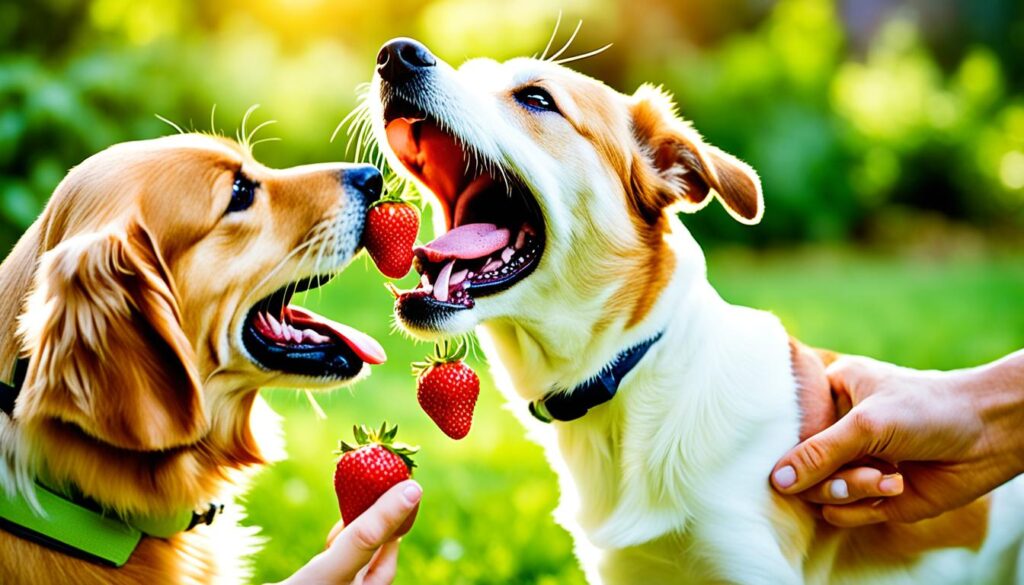
Gradual Incorporation: Just like with any new food, it is essential to introduce strawberries gradually into your dog’s diet. Start by offering them a small portion and assess their response. If there are no adverse effects, you can slowly increase the amount over time. This gradual approach allows your dog’s digestive system to adjust to strawberries and minimizes the risk of gastrointestinal issues.
By following these guidelines, you can introduce strawberries to your dog with confidence. Remember, every dog is different, and it’s important to monitor their individual response to ensure their well-being. Now that you know how to introduce strawberries to your furry friend, let’s explore some other considerations when feeding them this delicious fruit.
Limitations and Considerations
While strawberries can be a tasty addition to your dog’s diet, it’s essential to remember that they should only make up a small portion of their overall food intake. It’s important to consider the limitations and potential risks associated with feeding strawberries to dogs. Here are a few key considerations:
1. Treats should not exceed 10% of their daily calorie intake:
When giving your dog strawberries or any other treats, it’s crucial to keep moderation in mind. Treats, including strawberries, should only account for a small percentage (up to 10%) of their daily calorie intake. This ensures that their main meals meet their nutritional needs while treats remain just that—a special reward or occasional indulgence.
2. Dogs with specific dietary restrictions or health conditions:
Some dogs may have dietary restrictions or health conditions that require modified feeding guidelines. For example, if your dog has diabetes or is on a weight management plan, their strawberry consumption may need to be limited or monitored more closely. It’s always best to consult with a veterinarian to determine the appropriate amount of strawberries or other treats for your dog’s specific needs.
3. Potential digestive issues:
While strawberries are generally safe for dogs, they do contain natural sugars and fiber that can cause stomach upset if consumed in excessive amounts. If you notice any signs of digestive discomfort, such as diarrhea or vomiting, it may be a sign that your dog is not tolerating strawberries well. In such cases, it’s best to reduce or eliminate strawberry consumption and consult with a vet if the issues persist.
4. Pesticide residues and allergies:
Strawberries are part of the “Dirty Dozen” list of fruits and vegetables that are more likely to contain pesticide residue. It’s essential to thoroughly wash strawberries before feeding them to your dog, and consider choosing organic options when available. Additionally, like humans, dogs can be allergic to strawberries. If you notice any signs of an allergic reaction, such as itching, redness, or swelling, discontinue feeding strawberries and consult your veterinarian.
By considering these limitations and taking the necessary precautions, you can ensure that feeding strawberries to your dog remains a safe and enjoyable experience.
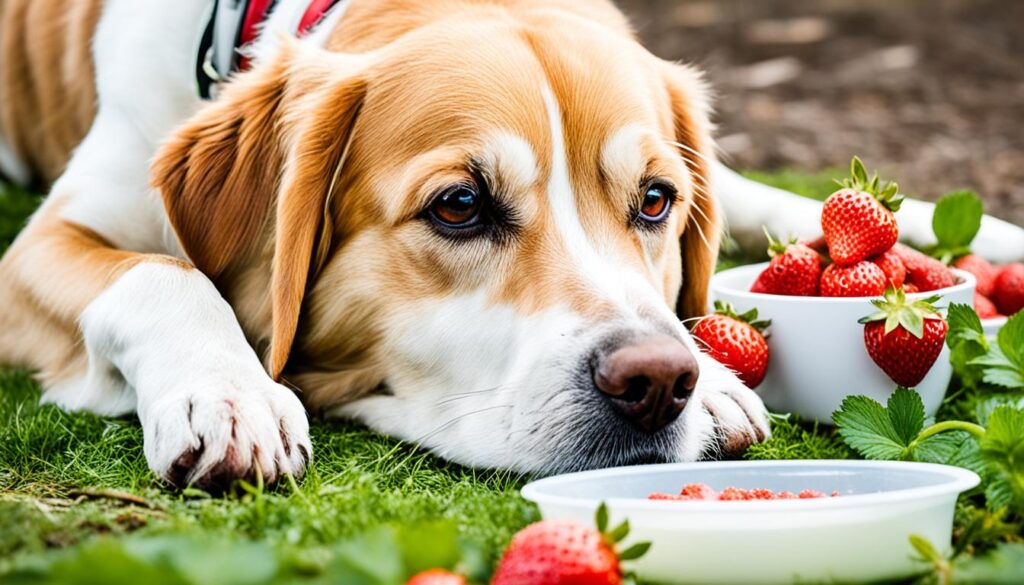
Other Fruity Treats for Dogs
In addition to strawberries, there are many other delicious and safe fruits that dogs can enjoy. Including a variety of fruits in your dog’s diet can provide them with essential nutrients and add some tasty variety to their meals. Here are a few examples of nutritious and dog-friendly fruits:
- Apples: Apples are a great source of vitamins A and C, as well as fiber. Remember to remove the seeds and core before offering them to your dog.
- Blueberries: Blueberries are rich in antioxidants and can contribute to your dog’s overall well-being. Serve them as an occasional treat or mix them into their food.
- Watermelon: Watermelon is a hydrating and refreshing fruit that dogs can enjoy. Remove the seeds and rind, and offer small pieces as a summer snack.
- Bananas: Bananas are packed with potassium and fiber. They can be a healthy and low-calorie treat for dogs. Just make sure to remove the peel before feeding.
When introducing these fruits to your dog, start with small portions to ensure they tolerate them well. Monitor their digestion and watch out for any allergic reactions. It’s important to do thorough research on each fruit to understand the potential benefits and risks before including them in your dog’s diet. Remember, moderation is key when it comes to feeding fruits to dogs.
“Adding a variety of fruits to your dog’s diet can provide them with essential nutrients and add some tasty variety to their meals.”
By offering your dog different types of safe fruits like apples, blueberries, watermelon, and bananas, you can provide them with a range of vitamins, minerals, and antioxidants. Experimenting with different fruits can also be a fun and enriching experience for your furry friend.
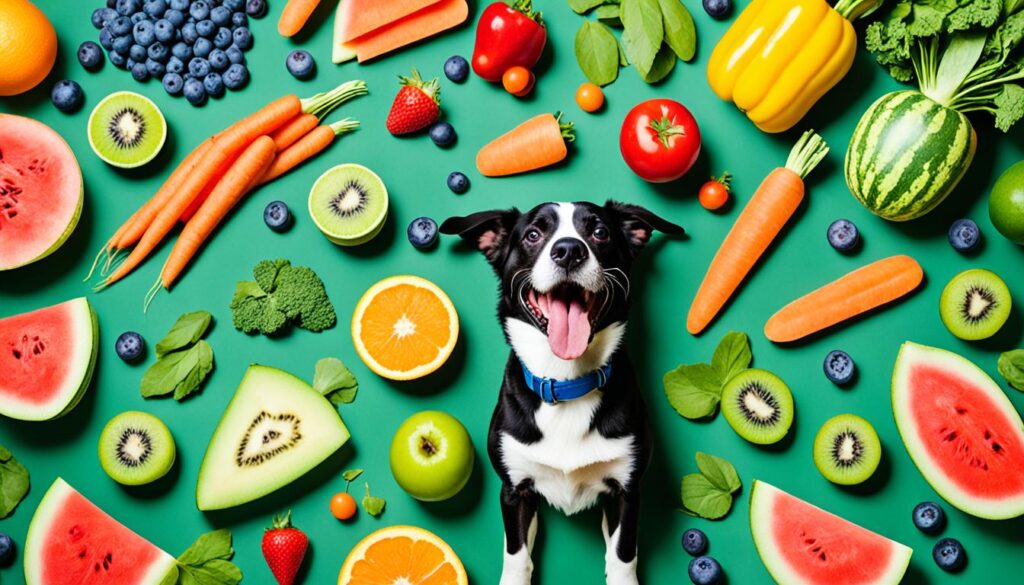
Conclusion
In conclusion, feeding strawberries to dogs can be a delightful and healthy addition to their diet when done responsibly. These vibrant fruits offer a range of nutritional benefits and can be a tasty treat for our canine companions. However, it is essential to adhere to safe consumption guidelines and take into account potential risks and individual dietary needs.
Strawberries provide dogs with valuable antioxidants, vitamins, and minerals that support their overall well-being. The fiber content aids in digestion, while vitamins C and K promote a robust immune system and bone health. By incorporating strawberries into their routine, dogs can enjoy improved hydration, healthy skin and coat, and a delightful texture to their meals.
Nevertheless, it is important to exercise caution when introducing strawberries to dogs. Small pieces should be provided to avoid choking hazards, and excess sugar consumption should be avoided to prevent stomach upset. Additionally, washing strawberries thoroughly and opting for organic options can reduce potential exposure to harmful pesticide residues.
Consulting with a veterinarian is always recommended to ensure individual needs and dietary restrictions are taken into account. Veterinarians can offer personalized advice and guidance on incorporating strawberries into a dog’s diet, ensuring optimal health and well-being.
Remember: Strawberries should be enjoyed in moderation as part of a balanced diet for dogs, and treats, including strawberries, should not exceed 10% of their daily calorie intake.
Final thoughts on strawberries for dogs
- Strawberries are a nutritious and delicious treat for dogs
- They offer antioxidants, vitamins, and minerals that support overall health
- Safe consumption guidelines should be followed, including washing thoroughly and cutting into small pieces
- Strawberries should be fed in moderation and should not exceed 10% of a dog’s daily calorie intake
- Always consult with a veterinarian for personalized advice and to consider individual dietary needs
By responsibly incorporating strawberries into a dog’s diet, we can provide them with a healthy and enjoyable snack that contributes to their overall well-being.
| Benefits of Feeding Strawberries to Dogs | Risks and Considerations | Safe Consumption Guidelines |
|---|---|---|
|
|
|
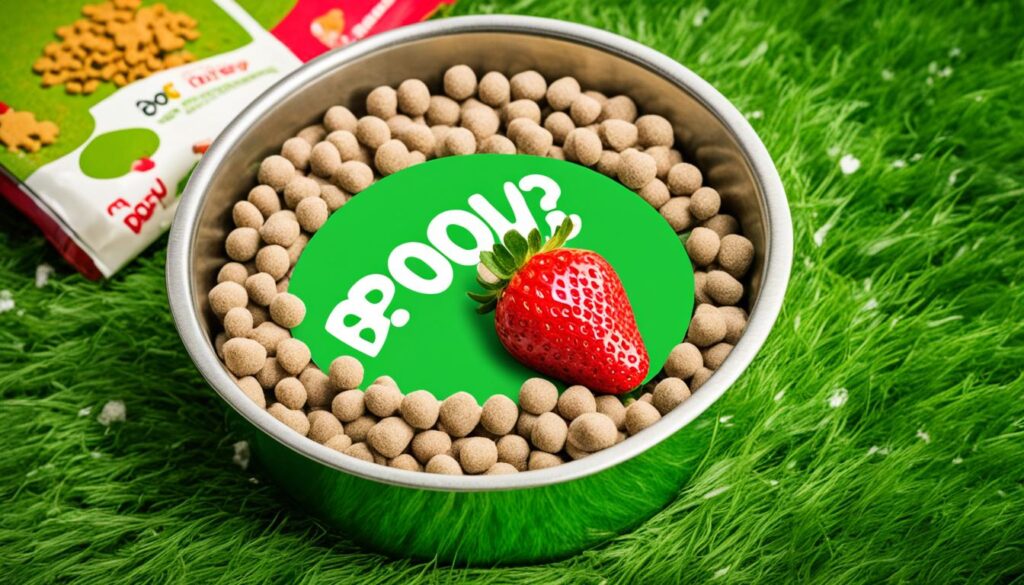
Next Article: Can Dogs Eat Turkey? When to Feed & When to Avoid
The next article will provide valuable insights into the topic of dogs eating turkey. We will explore whether it is safe to feed dogs this protein-rich meat and provide important information on when to feed it and when to avoid it. Our comprehensive guide will cover various considerations such as cooked or raw turkey, the safety of bones, and potential health risks associated with feeding dogs turkey.
Stay tuned for this informative article that will help you make informed decisions regarding your dog’s diet and ensure their health and well-being.

Newsletter Signup
Sign up for our free pet-parenting newsletters to receive expert advice and tailored articles for your beloved pet. At [Company Name], we understand that being a pet parent comes with its unique challenges and joys. That’s why our in-house team of professionals, including veterinarians and behaviorists, are here to provide you with valuable insights and support.
Our newsletters cover a wide range of topics, including pet care advice, behavior training, nutrition tips, health guidance, and much more. Whether you have a playful puppy, a curious kitten, or a loyal senior companion, our newsletters offer relevant and timely information to help you navigate the world of pet parenting with confidence and care.
In addition to helpful content, by signing up for our newsletters, you’ll also gain exclusive access to special discounts and offers from our trusted partner brands. We believe that every pet deserves the best care, and our newsletters are designed to empower you to give your furry friend a happy, healthy, and fulfilling life.
Join our newsletter community today and stay informed about the latest pet care trends, expert advice, and exciting promotions. Sign up now and become part of our thriving community of pet lovers!
FAQ
Are strawberries safe for dogs to consume?
What are the benefits of strawberries for dogs?
What are the potential risks of feeding strawberries to dogs?
How should strawberries be safely fed to dogs?
Can dogs eat other strawberry items?
What is the impact of strawberries on a dog’s health?
How should strawberries be introduced to dogs?
What are the limitations and considerations when feeding strawberries to dogs?
Are there other fruits that are safe for dogs to enjoy?
What are the final thoughts on feeding strawberries to dogs?
What will the next article cover?
How can I sign up for pet-parenting newsletters?
Paul’s love for animals knows no bounds. As a dedicated writer and animal lover, Paul brings a unique perspective to our team. His firsthand experiences with various animals enrich our content and provide valuable insights into their behavior and needs. Whether he’s sharing tips for pet care or shedding light on pressing conservation issues, Paul’s passion for animals shines through in everything he does.
Dogs
Punning Around With 5 Hilarious Name Puns
Journey through the whimsical world of name puns with 5 hilarious examples that will leave you in stitches.

Name puns are a fun way to add humor to conversations. Clever twists on names can spark laughter and showcase creativity. For chuckle-worthy inspiration, consider puns like Sal Pinkingside and Sofonda Cox. These humorous wordplays inject wit into everyday interactions. Characters such as Ms. Bea Verlicker or Dr. Needleman also illustrate the entertaining power of name puns. Playing with sounds or meanings of names leads to delightful discoveries. Stay tuned for more hilarious examples that will surely tickle your funny bone.
Key Takeaways
- Clever name puns add a lighthearted touch to conversations with funny twists and linguistic creativity.
- Harry Potter universe inspires laugh-out-loud name puns that showcase linguistic humor.
- Name-based humor delights by showcasing wit, creativity, and engaging conversations.
- Hilarious name pun examples like Sal Pinkingside and Sofonda Cox inject humor into everyday experiences.
- Transforming ordinary names into sources of laughter with playful twists and clever wordplays.
Clever Name Wordplay
Exploring clever name wordplay reveals the delightful art of crafting puns and jokes based on names. Name puns, especially funny puns, add a lighthearted touch to conversations and interactions. These clever twists on names can be witty, entertaining, and bring a smile to people's faces.
Playing with the sounds or meanings of names through puns showcases linguistic creativity and a playful sense of humor. It's fascinating how a simple play on words can spark laughter and amusement, making conversations more engaging and enjoyable. Name puns are like little linguistic puzzles that entertain and create a connection through shared humor.
Crafting funny puns based on names requires a keen eye for wordplay and a knack for finding humor in unexpected places. Embracing the world of name puns opens up a universe of creativity and laughter, where the art of clever wordplay shines brightly.
Laugh-Out-Loud Name Twists

In the domain of clever name wordplay, chuckle-inducing name twists showcase the peak of linguistic humor and creativity. When it comes to name puns that elicit laughter, the Harry Potter universe offers a treasure trove of inspiration. Imagine Professor Sprout turning into Professor Sizzle with a knack for good food puns or Severus Snape brewing up some 'spellbinding' dishes. These playful twists on well-known names add a dash of magic to the pun game.
Exploring different types of puns can lead to delightful discoveries. Just like a good meal, a well-crafted pun can leave you satisfied and smiling. From names like Sal Pinkingside to Dr. Needleman, the art of incorporating wordplay into names never fails to amuse. Whether it's a subtle play on words or a more overt joke, the creativity behind these puns is truly impressive.
Name-Based Humor Delights
Name-based humor's charm lies in its ability to tickle the funny bone by cleverly playing with the sounds, meanings, or associations of names to create humorous situations. When it comes name-based humor delights, here are some key points to ponder:
- Creative Wordplay: Name puns often involve creative wordplay that can range from simple plays on words to more elaborate scenarios, showcasing the cleverness of the punster.
- Humor Everywhere: This type of humor is popular in various settings, from comedy shows to social media and everyday conversations, as people love the light-hearted and entertaining nature of name-based jokes.
- Wit and Creativity: Name-based humor allows individuals to showcase their wit and creativity in coming up with clever punch lines that can leave others in stitches.
- Engaging Conversations: Using name puns can make conversations more engaging and memorable, creating moments where laughter is inevitable and no one wants to run away from the fun.
Hilarious Name Pun Examples

Shifting from the realm of name-based humor's charm, let's now display some uproarious examples of hilarious name puns that are sure to tickle your funny bone.
Every time I think of punny names, my friend David's favorite pops to mind – Sal Pinkingside, a play on the word 'saltpeter,' delivering a dash of wit with a pinch of creativity. Another classic is Sofonda Cox, a name that never fails to elicit a chuckle. Then there's Bart Simpsons Amanda Hugankiss, a clever twist on the phrase 'I'm gonna kiss Amanda Hugankiss.'
We can't forget the real-life doctors who bring humor to their profession with amusing last names. Dr. Needleman and Dr. Hertzberg inject a dose of laughter into their patients' lives, while Dr. Wong See and Dr. Slaughter carve out a smile with their playful titles. And who could overlook Ms. Bea Verlicker, a fictional character whose name cleverly plays with words? These punny names, like the toppings on a Hawaiian pizza, add a delightful touch of humor to our everyday experiences.
Chuckle-Worthy Name Play
With a talent for transforming ordinary names into sources of laughter, we revel in the art of crafting chuckle-worthy name play. When it comes to name puns, we love to sprinkle a bit of humor into everyday interactions. Here are some examples that will surely bring a smile to your face:
- Man Driving: Imagine this – a man named Miles driving down the road. It's a classic case of literal humor that never fails to amuse the people around.
- Doctor Said: Envision a scenario where a person named Paige visits the doctor. The doctor said, 'Looks like you've turned a new leaf, Paige!' – a pun that lightens up the medical visit with a playful twist.
- People Around: How about a guy named Luke walking into a room full of Star Wars fans? The excitement among the people around is palpable as they exclaim, 'Luke, I'm your fan!'
- Name Game: Playing the name game can be fun, especially when 'Holly' transforms into 'Holly-wood' right before your eyes. It's these simple yet clever wordplays that make name puns so enjoyable.
Frequently Asked Questions
How Did Puns Come to Be Associated With Humor and Wordplay?
Puns became linked with humor and wordplay due to their ability to create clever and unexpected connections between words. Their playful nature allows for humor to be infused into language, making them a beloved form of wit.
Are There Any Famous Comedians or Writers Known for Their Use of Puns?
We love how some famous comedians and writers have mastered the art of puns. They infuse humor and clever wordplay seamlessly into their work, leaving us in stitches. It's a true talent that never fails to entertain.
Can Puns Be Considered a Form of Intellectual Humor?
Puns, like a clever riddle, tickle the intellect with their wordplay. We find them a delightful form of intellectual humor, weaving wit into language effortlessly. They offer a playful twist, making us smile.
What Is the Psychology Behind Why Puns Are Funny to Some People but Annoying to Others?
Puns' humor can vary due to individual preferences and cognitive processes. Some find them amusing because they require quick wit and mental flexibility. Others might find them irritating due to differing senses of humor or lack of appreciation for wordplay.
Are There Any Cultural Differences in the Perception and Appreciation of Puns?
In some cultures, puns are revered for their wit and cleverness, while in others, they might not land as well. Understanding these nuances helps us appreciate the diverse ways people interpret and enjoy humor.
Conclusion
To wrap things up, name puns can add a touch of humor and creativity to everyday conversations. Just like a sprinkle of cinnamon enhances the flavor of a dish, clever wordplay can spice up interactions and bring a smile to people's faces.
So don't be afraid to pun around with names and enjoy the laughter and joy it brings to all those around you. Let your wit shine and spread the joy of puns far and wide!
As our Editor-in-Chief, James plays a pivotal role in ensuring the quality and integrity of our content. With a keen eye for detail and a passion for storytelling, James oversees the editorial process here at A Place for Animals. With years of experience in content editing, James ensures that every piece of content meets our high standards of accuracy and clarity. Under James’ guidance, you can rest assured that the content you read is informative and impeccably crafted.
Dogs
Are Philodendrons Toxic to Dogs?

Philodendrons can be harmful to dogs because they contain calcium oxalate crystals, causing issues like oral irritation, drooling, vomiting, and throat swelling when eaten. If your dog shows signs of ingesting Philodendrons, act fast. Wash their mouth with cool water, remove the plant, and watch for symptoms. Immediate vet help is crucial if things worsen. Prevent recurrence by keeping Philodendrons out of reach. Recognizing these risks guarantees pet safety.
Key Takeaways
- Philodendrons contain calcium oxalate crystals that can cause oral irritation and swelling in dogs.
- Symptoms of Philodendron toxicity in dogs include drooling, vomiting, oral pain, and breathing difficulties.
- Immediate actions for Philodendron ingestion include flushing the mouth, removing the plant, and monitoring for symptoms.
- Treatment for Philodendron poisoning may involve pain relief, fluids, gastroprotective medications, and monitoring for airway swelling.
- Prevent exposure by keeping Philodendrons out of reach, watching for signs of ingestion, and seeking veterinary help promptly.
Potential Dangers of Philodendrons for Dogs
When handling Philodendrons around dogs, it's important to be mindful of the potential dangers they pose due to the insoluble calcium oxalate crystals they contain. These crystals, found in various parts of the plant, can cause irritation and swelling if ingested by our furry friends.
If a dog chews on or consumes a Philodendron, the crystals can trigger reactions like oral irritation, drooling, vomiting, throat swelling, and difficulty swallowing. Immediate action is vital in such situations to prevent further harm.
Moving the plant out of reach and monitoring the dog for any signs of distress are essential steps to take. Remember, Philodendrons are beautiful additions to our homes, but their presence can be risky for our canine companions. By being aware of the potential dangers these plants harbor, we can guarantee a safer environment for our beloved pets.
Symptoms of Philodendron Toxicity in Dogs

Considering the potential dangers of Philodendrons for dogs, it's important to recognize the symptoms of Philodendron toxicity that can manifest in our canine companions.
Some common signs of Philodendron poisoning in dogs include:
- Excessive drooling: Dogs may drool more than usual after ingesting Philodendrons due to oral irritation.
- Oral pain: Dogs might exhibit signs of discomfort in their mouth, such as pawing at the mouth or reluctance to eat.
- Swelling of the upper airway: In severe cases, dogs may experience swelling in their throat, which can lead to breathing difficulties.
- Vomiting: Dogs may vomit as a result of ingesting Philodendrons, a common reaction to plant toxicity.
- Decreased appetite: A noticeable decrease in appetite can signal that a dog has consumed something toxic like Philodendrons.
Recognizing these symptoms promptly and seeking veterinary care is essential to safeguard the well-being of our beloved furry friends.
Immediate Actions for Philodendron Ingestion

Upon discovering Philodendron ingestion by a dog, promptly flush their mouth with cool water to remove toxins. This helps reduce the risk of irritation caused by calcium oxalate crystals present in the plant. Moving the Philodendron out of reach prevents further ingestion, minimizing the chances of more severe symptoms like swelling of the upper airway. Monitoring the dog for signs of upset stomach, such as drooling or vomiting, is essential. Immediate veterinary attention is vital if symptoms worsen or if there is difficulty breathing. Taking quick action can help alleviate the effects of Philodendron toxicity on dogs.
| Immediate Actions for Philodendron Ingestion | ||||
|---|---|---|---|---|
| Flush dog's mouth with cool water | Remove the plant | Monitor symptoms | Seek vet advice | Prevent re-ingestion |
| to remove toxins | from the dog's | Monitor signs of | Consult a vet | by moving the plant |
| environment | oral discomfort | if symptoms worsen | out of the dog's | |
| like drooling, | or breathing | reach |
Treatment Options for Philodendron Poisoning

To address Philodendron poisoning in dogs, veterinarians may recommend a combination of treatments tailored to the pet's specific symptoms and severity of ingestion. When dealing with Philodendron toxicity, it's vital to act promptly to alleviate any discomfort and prevent further complications. Here are some common treatment options for Philodendron poisoning in dogs:
- Flushing the pet's mouth: This helps remove calcium oxalate crystals present in the plant material.
- Pain relievers or antihistamines: Veterinarians may prescribe these to alleviate pain and swelling caused by Philodendron ingestion.
- Intravenous fluids: Administered to prevent dehydration in pets that have ingested significant amounts of the toxic plant material.
- Gastroprotective medications: Given to protect the stomach lining from the harmful effects of Philodendron toxicity.
- Monitoring upper airway swelling: Close monitoring is crucial until the swelling subsides to guarantee the pet's airway remains clear and safe.
These treatment options are essential in managing Philodendron poisoning in dogs and promoting their recovery.
Preventing Philodendron Exposure to Dogs

To keep dogs safe from Philodendron toxicity, it is important to proactively prevent their exposure to the plant. One vital step is to make sure philodendron plants are placed in areas that are inaccessible to your furry friends. Here is a helpful table to illustrate some key prevention measures:
| Prevention Measures | Description |
|---|---|
| Keep plants out of reach | Position philodendrons in high areas or behind barriers. |
| Monitor for ingestion | Watch for signs of chewing or attempts to eat plants. |
| Educate about symptoms | Learn about signs of plant toxicity in dogs. |
| Create a safe environment | Remove toxic plants and provide pet-friendly options. |
| Seek veterinary help | If ingestion occurs, contact a vet immediately. |
Frequently Asked Questions
What Happens if a Dog Eats a Philodendron?
If a dog eats a Philodendron, it can experience extreme mouth and throat irritation from calcium oxalate crystals. Symptoms like drooling, vomiting, and difficulty swallowing may occur. Immediate actions include rinsing the mouth with water and seeking veterinary care.
Philodendron poisoning can lead to pain, swelling, and gastrointestinal issues, requiring monitoring and treatment. Preventing dogs from accessing Philodendron plants is essential to avoid potential toxicity and health complications.
How Toxic Is Philodendron?
Philodendrons contain insoluble calcium oxalate crystals that can cause severe irritation in dogs if ingested. Symptoms like drooling, vomiting, and difficulty swallowing may occur.
Immediate action is crucial – move the plant out of reach and monitor for symptoms. Treatment may involve rinsing the mouth, acid reducers, and veterinary care.
Long-term effects vary, stressing the importance of prompt action and monitoring for adverse reactions.
Is Heartleaf Philodendron Toxic to Dogs?
Heartleaf Philodendron is toxic to dogs due to calcium oxalate crystals. Ingestion can lead to oral irritation, drooling, vomiting, and difficulty swallowing. If this happens, rinse the mouth, move the plant away, and watch for symptoms.
Treatment involves pain relief, fluids, and gastroprotective meds. Recovery is usually good for small ingestions, but monitor for lingering signs. It's essential to act fast and seek vet care if needed.
What Is the Most Poisonous Plant for Dogs?
We should be cautious about the most poisonous plant for dogs, the Sago Palm, due to its toxic cycasin content. Ingestion can swiftly lead to severe liver issues and even death for our canine companions.
Symptoms like vomiting, diarrhea, lethargy, jaundice, and seizures are immediate red flags. Quick action must be taken by seeking veterinary care if a dog consumes any part of a Sago Palm to avoid dire consequences.
Conclusion
To summarize, it's important to be mindful of the potential hazards of philodendrons for dogs. If your beloved companion consumes any part of this plant, it can result in significant health problems.
Remember to keep philodendrons out of reach and seek prompt veterinary care if ingestion occurs.
Stay watchful and prioritize your pet's safety to guarantee a happy and healthy life for your canine friend.
Dana is our Lead Content Writer, bringing a wealth of knowledge and expertise to our team. With a background deeply rooted in animal studies and a profound love for all creatures, Dana is dedicated to crafting engaging and informative content that resonates with our audience. With Dana at the helm, you can trust that our content is accurate and engaging, catering to the diverse interests of animal enthusiasts everywhere.
Dogs
How to Choose a Good Name for Your Kitten
Craft the perfect name for your kitten with tips on considering personality traits, cultural influences, and more – find the ideal fit!

When naming your kitten, consider personality traits, appearance, ease of pronunciation, and cultural influences. Choose a name that reflects your feline friend's unique characteristics and strengthens your bond. Match names like Whiskers for curiosity or Luna for energy. Opt for simple, 1-2 syllable names like Tiger or Puss. Pick names that can grow with your kitten. Look to habits or quirks for inspiration. Make certain the name is easy to pronounce for clear communication. Let joy guide your choice. Make sure the name brings you happiness and connects you with your pet. The right name is essential for your kitten's identity.
Key Takeaways
- Consider kitten's personality traits like playfulness or curiosity.
- Reflect appearance, such as color, markings, or breed.
- Ensure name is easy to pronounce and distinguish.
- Incorporate cultural influences for added meaning.
- Choose a name that can grow with the kitten.
Factors to Consider
When selecting a name for your kitten, we should meticulously consider various factors to make sure it suits their unique personality and characteristics. The name we choose should resonate with their personality traits, whether they're playful, curious, or affectionate.
It's crucial to observe their appearance, considering their color, markings, or breed, to find a name that truly fits. Additionally, we must make certain the selected name is easy to pronounce and distinguish, particularly for young children or family members who interact with the kitten.
Cultural influences can also play a significant role in naming our furry friend, honoring heritage and adding an extra layer of meaning to their identity. By incorporating favorite shows, movies, interests, or associations into the name, we can create a moniker that brings joy to both us and our kitten, forming a special bond through a name that holds significance for all involved.
Personality Matching

Matching your kitten's personality to the perfect name is essential for creating a strong bond and understanding their unique traits. When considering cat names, think about your kitten's playful nature. Names like Whiskers can suit a curious kitten who loves to explore and play.
For a feline friend with an energetic personality, options like Sparky or Luna can be fitting choices, reflecting their lively and spirited nature. If your kitten has a sweet demeanor, names such as Angel or Sweetie can emphasize their gentle and affectionate qualities.
On the other hand, if your kitten shows an independent streak, names like Maverick or Rebel might be more suitable, highlighting their bold and adventurous spirit. Additionally, for a mischievous little troublemaker, names like Bandit or Mischief can capture their playful side.
Consider these aspects of your kitten's personality when selecting the perfect name to truly connect with your new furry companion.
Naming Tips for Kittens
When naming your kitten, consider choosing a name that reflects their personality traits, such as Rascal or Princess. Additionally, popular kitten names like Tiger, Puss, and Smokey are commonly used and easy to remember.
Opt for short names with 1-2 syllables for quick learning, and select a name that can grow with your kitten to prevent frequent changes.
Personality-Based Naming
Considering your kitten's unique personality is essential when choosing a name that resonates with their traits and characteristics. Names like Rascal or Whiskers are perfect for playful kittens who love to romp around and explore.
If your feline friend is sweet and gentle, names like Angel or Cuddles may suit them well. For curious kittens who are always on the lookout for new adventures, names like Scout or Cleo could be fitting choices.
And if your kitten tends to get into a bit of trouble now and then, names like Mischief or Trouble might capture their mischievous spirit. Tailoring the name to your kitten's individuality will help strengthen the special bond you share.
Popular Kitten Names
Which popular kitten names are most suitable for your new feline companion?
When considering cat names, opting for ones with two syllables or less, like Tiger, Puss, Smokey, or Ginger, can help your kitten learn and respond quickly.
Involving the family in the naming process not only makes it a fun activity but also guarantees everyone feels connected to the chosen name.
Choosing names based on personality traits, such as Rascal, Princess, Fluffy, or Midnight, can be a fitting way to reflect your kitten's characteristics.
Inspiration From Behavior

When selecting a name for your kitten, it's crucial to draw inspiration from their behavior. Observing characteristics like playfulness, affection, energy, curiosity, or adventurousness can lead you towards suitable names.
Naming From Quirks
Observing a kitten's unique behaviors and quirks provides valuable inspiration for choosing a fitting name that captures their individuality. When considering cat names based on personality traits, names like Pounce or Zoom can be perfect for an active and playful kitten that loves to run around and play.
Alternatively, if your kitten is more on the cuddly side, names like Snuggle or Cuddles can be a great match for their affectionate nature. Tailoring the name to reflect specific habits or preferences your kitten displays guarantees a name that truly resonates with their character.
Reflecting Temperament Traits
Reflecting a kitten's temperament traits through their name choice can provide insight into their behavior and character, enhancing the bond between pet and owner. When selecting a name for your feline friend, consider how their personality can be mirrored in their name. Here are some examples to guide you in choosing a name that reflects your kitten's unique temperament traits:
| Personality Trait | Name Suggestions |
|---|---|
| Energetic and mischievous | Rascal |
| Playful and curious | Whiskers |
| Regal and elegant | Princess |
| Affectionate and cuddly | Snuggles |
| Loves to follow you around | Shadow |
Easy Pronunciation

Considering the importance of clear communication between you and your kitten, opt for a name with easy pronunciation that both of you can effortlessly recognize. Simple names with clear and distinct sounds are ideal for your new cat.
Avoid complex or difficult names that might confuse your furry friend. Opt for a name that even young children or family members can easily say. A straightforward name not only fosters a strong bond between you and your kitten but also helps during training sessions.
When choosing a name, think about how it will sound when you call it out – a name that rolls off the tongue will make interactions smoother and more enjoyable. Remember, a name that's easy to pronounce isn't only practical but also enhances the relationship between you and your adorable feline companion.
Reflecting Individuality

We customize our kitten's name to highlight their unique characteristics and personality traits. When selecting cat names, it's crucial to contemplate what makes your kitten stand out.
If your feline friend is unusually friendly or shy, you might choose a name that mirrors these traits, like 'Sunny' for a sociable kitty or 'Whisper' for a more reserved one. For intelligent breeds, names like 'Brainy' or 'Einstein' can be appropriate choices to showcase their cleverness.
Reflecting individuality through a name can also entail emphasizing your kitten's quirks; a playful kitten could be named 'Rascal,' while a regal-looking one might suit the name 'Prince.' Remember, your kitten's name is a reflection of their identity, so select one that resonates with their uniqueness.
You can even draw inspiration from their appearance, such as naming an orange kitten 'Pumpkin' or a fluffy white kitten 'Snowball.' Each name has the ability to capture your kitten's essence and celebrate what makes them truly one of a kind.
Avoiding Complex Names

Choosing a simple name for your kitten can enhance their learning and responsiveness. When selecting a name for your feline friend, it's important to opt for something easy to remember and pronounce. Avoiding complex names with multiple syllables or difficult sounds can make training and communication much smoother for both you and your kitten. Here is a helpful table to guide you in choosing a straightforward name for your new pet:
| Easy to Remember Cat Names | Examples |
|---|---|
| Short and Sweet | Luna, Max, Bella |
| Single-Syllable Names | Milo, Rose, Jack |
| Common Words | Shadow, Whiskers, Lily |
| Soft Sounds | Daisy, Oliver, Peanut |
Joyful Name Selection

When naming your kitten, let the joy in your heart guide you to a name that resonates with happiness each time you call out to your furry companion. Choosing a name that brings a smile to your face can enhance the bond between you and your new pet. Incorporating favorite shows, movies, or interests into the naming process can add an extra layer of joy.
Consider associations like the month you welcomed your kitten into your family or names inspired by beloved artists. It's crucial to make sure that the selected name not only suits your kitten but also brings you delight every time you interact with them. Involving your family in the naming decision can also spread joy and create a shared connection with your pet.
Frequently Asked Questions
What Should I Name My New Kitten?
We're thrilled about your new kitten! Let's consider their personality traits and appearance for inspiration. Involving the family will create a special bond. Choose a name that brings joy and reflects their uniqueness.
What Is a Good Name for a Baby Kitten?
We think a good name for a baby kitten should reflect their unique personality. Short names like Luna or Milo are cute and easy for our feline friends to learn. It's important to choose a name that resonates with us and our kitten.
Is It OK to Rename a Kitten?
It's absolutely okay to rename a kitten! Cats can adapt to new names if introduced gradually. Keep the shelter-given name if familiar, but choose a new one with a similar sound if necessary. Make sure the new name is simple and frequently used.
What Names Do Cats Respond Better To?
We find that cats respond best to short, 1-2 syllable names with a vowel sound at the end. Double syllable names work well too. Avoid complex names that confuse. Unique names help in clear communication and prevent mix-ups.
Conclusion
Choosing a good name for your kitten is an important decision that reflects their personality and individuality. Consider factors like personality matching, easy pronunciation, and avoiding complex names to guarantee a joyful name selection process.
For example, when I named my kitten Luna, her playful and curious nature perfectly matched her name, bringing joy and harmony to our home. Taking the time to choose the right name for your furry friend can create a special bond that lasts a lifetime.
As our Editor-in-Chief, James plays a pivotal role in ensuring the quality and integrity of our content. With a keen eye for detail and a passion for storytelling, James oversees the editorial process here at A Place for Animals. With years of experience in content editing, James ensures that every piece of content meets our high standards of accuracy and clarity. Under James’ guidance, you can rest assured that the content you read is informative and impeccably crafted.
-

 Vetted2 months ago
Vetted2 months ago15 Best Cat Foods for Managing Hyperthyroidism – Vet Approved and Feline Friendly
-

 Animal Facts2 months ago
Animal Facts2 months agoSpring Animals: A Guide to Seasonal Wildlife
-

 Cats7 months ago
Cats7 months agoTop 5 Cat Breeders in Arkansas: A Guide
-

 Vetted1 month ago
Vetted1 month ago15 Best Dog Foods for Kidney Disease – Expert Recommendations for Your Pet's Health
-

 Vetted2 months ago
Vetted2 months ago15 Best Fresh Dog Food Delivery Services for Your Pup's Health and Happiness
-

 Rabbits2 months ago
Rabbits2 months agoExploring Rabbit Holes: What Do They Look Like?
-

 Pets2 months ago
Pets2 months agoLatest Pet Statistics in US – Trends & Insights in 2024
-

 Fish2 months ago
Fish2 months agoKeeping Your Sucker Fish Thriving at Home























